One of the ways to increase your chances of ranking for high volume keywords on Google is to create pillar pages and topic clusters.
Although this is not a new concept, with the latest changes to the Google ranking algorithm and the introduction of AI, it has become more important.
One of the characteristics of pillar pages (also referred to as long-form articles, content pillars or cornerstone content), that differentiates them from normal articles or blogs is that they are comprehensive, usually bigger in word length and they cover a particular topic (not a single keyword) in detail.
In this guide, you’ll learn what are pillar pages, why they are important for modern SEO and the 10 steps to follow to create pillar pages for your website.
- What are pillar pages?
- Why are pillar pages important for SEO?
- How to create pillar pages (10 Steps)
What are pillar pages?
A pillar page is a long-form content page that covers a specific topic in detail. It provides users with everything they need to know about the particular topic and links to related resources for further exploitation.
A pillar page can stand on its own or be part of a topic cluster. Pillar pages are used to target high volume topics and head keywords.
The main characteristics of pillar pages are:
- They are usually longer than normal blog posts.
- Content is around a specific topic
- The content is broken down into sections
- Each section covers a specific sub-topic
Look at the diagram below to understand this better.
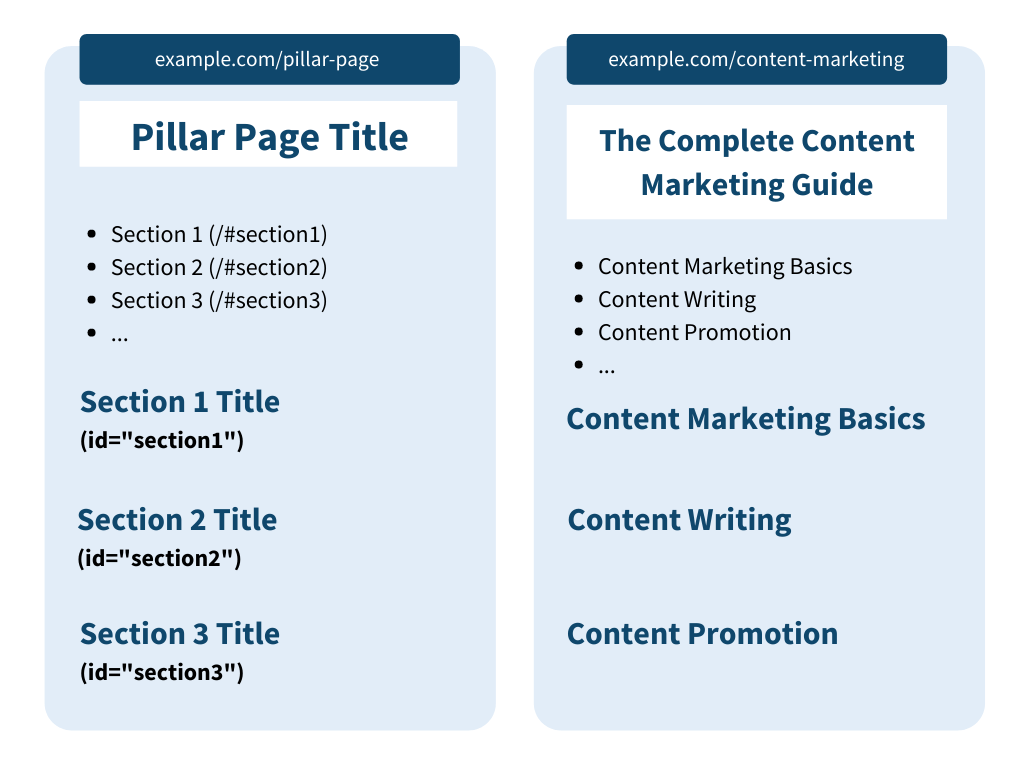
On the left, you can see how the structure of a pillar page looks like and on the right an example of how a pillar page about ‘content marketing’ would look like.
We’ll see below, in the ‘how to create a pillar page’ section, the process of choosing the right topics, headings, page title, URL and links for a pillar page.
Here is a real example of a pillar page published on this site on how to start an online business.

Why are pillar pages important for SEO?
There are many reasons why pillar pages are important for your SEO and content marketing efforts. The most important are:
They provide both users and search engines with the content they want – For some topics it’s more convenient for users to have all the information they need on one page instead of browsing through different articles.
This is more convenient for search engines as well because it helps them serve users with results that keep them happy.
They can help you win featured snippets – The way pillar pages are structured makes it easier for search engines to crawl and meet all requirements for appearing at the top of the search results in the featured snippet box.
It’s a great way to prove your expertise about a topic – Google search ranking factors are heavily influenced by E-A-T (Expertise, Authority, Trustworthiness) and high-quality pillar pages are a great way to show to users and search engines that you are a trustworthy source for a topic.
Combined with a few quality backlinks, you can establish your website as an authority for a specific topic as well.
They can help you rank high for competitive keywords – Pillar pages are usually long-form content pages and this allows you to naturally include related keywords in the content which increases topic relevancy that (under conditions) leads to higher rankings.
Also, pillar pages are more likely to attract natural links from other websites and mentions on social media networks that in-turn leads to increasing Google trust which results in higher rankings.
How to create pillar pages
These are the 10 steps to follow to create a pillar page:
- Decide what topics to target using pillar pages
- Decide what format to use (Pillar page or topic clusters)
- Perform keyword research
- Create a content outline and write the content
- Name your sections
- Add Internal links to the different sections
- Format the page
- Promote your page (internally and externally)
- Write content for the supporting pages
- Add internal links back to the pillar page
1. Decide what topics to target using pillar pages
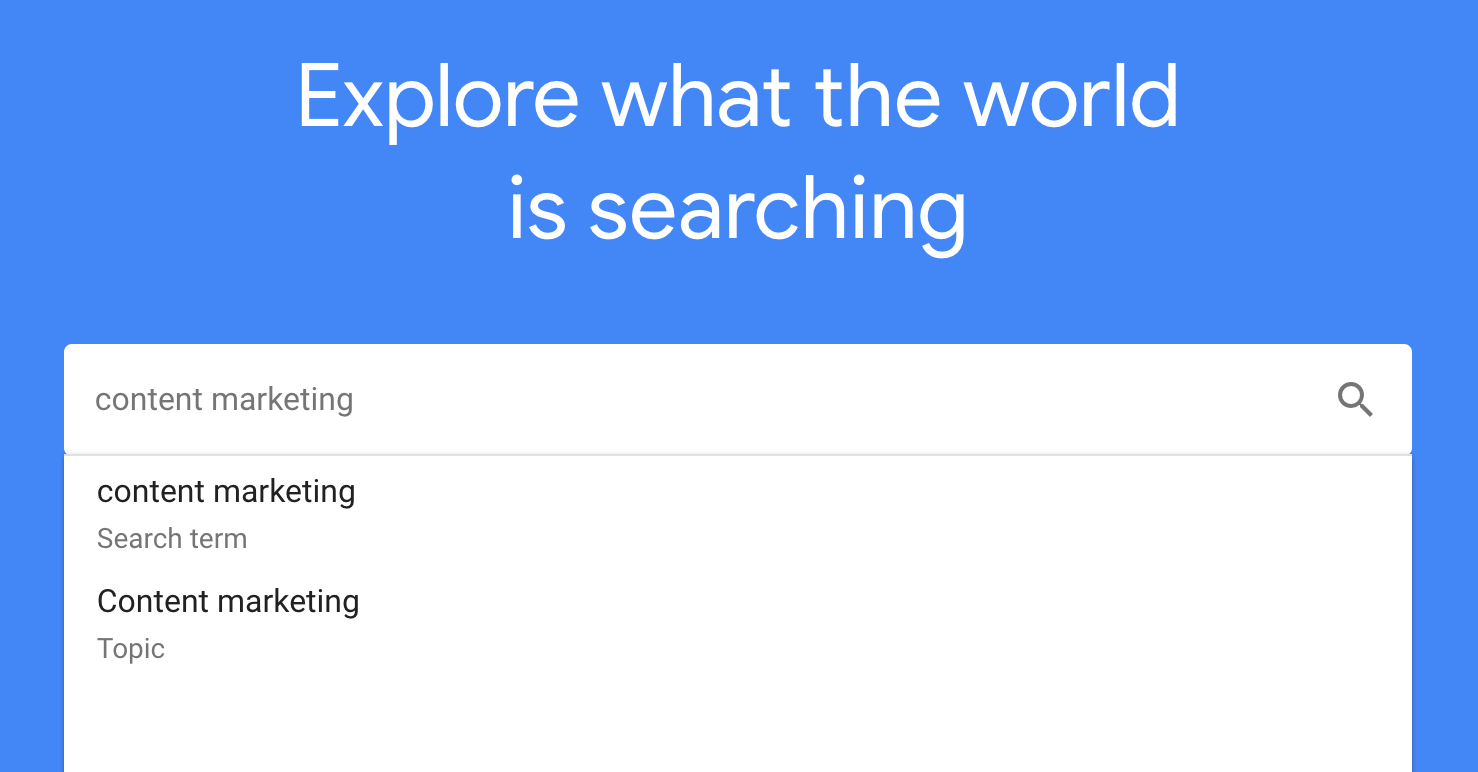
Obviously the first step is to decide what topic your pillar page should target.
This depends on the niche you are in and the topics/keywords already targeted by your existing content.
Some guidelines to follow:
Choose topics that are not too narrow – if a topic doesn’t have a lot of sub-topics then it might not be ideal for a pillar page. A blog post for those topics might be enough.
Choose topics that have a high search volume – Creating pillar pages take a lot of time and effort and it’s not worth going after low volume keywords.
Choose topics that are relevant to your audience and business – Choose topics that are relevant to what your audience might way to read and can potentially generate more conversions for your business.
Research your competitors – A great starting point is to analyze your main competitors and find out for which topics they have pillar pages and which topics they could have pillar pages but they don’t.
These are great candidates to start with because they will generate a competitive advantage for you.
Avoid content duplication – Before choosing a topic make sure that you don’t already have articles about the exact same topic published on your site.
The last thing you want to do create is to confuse search engines and run into duplicate content issues.
If you do have pages targeting identical topics then you can consider improving your existing articles and turning them into pillar pages, creating new content and redirecting the old pages to the new pillar pages (using 301 redirects) or choosing to go with topic clusters (more on this below).
2. Decide what format to use (Pillar page or topic clusters)
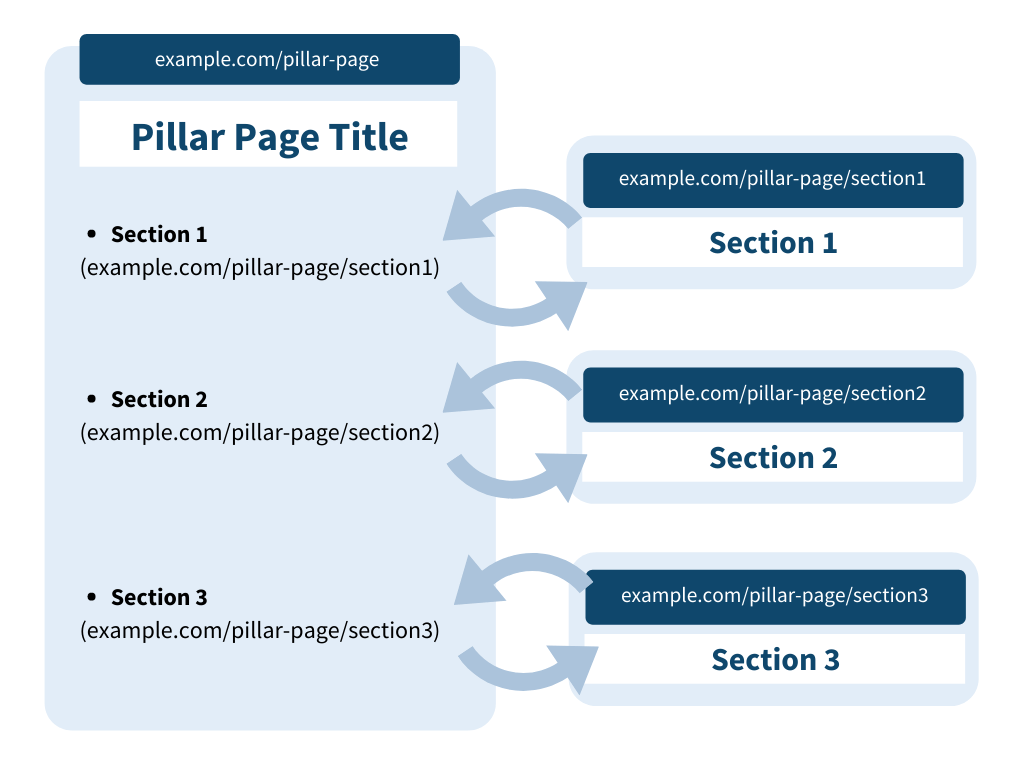
The next step is to decide what format to use for your pillar pages. There are two ways you can approach pillar pages.
Single Pillar Page
The first way is to have all content on one page, broken down into sections.
This is similar to the example demonstrated above. The main characteristics of this approach are:
- You have a single page targeting one high volume topic.
- The title of the page is general and contains the main keyword i.e. “The Complete Content Marketing Guide’.
- The URL of the page is an exact match of the main topic keyword. For example “/content-marketing”.
- The page URL comes directly after the domain name i.e. com/content-marketing
- At the top of the page, you have a table of contents. Each item points to a section on the same page.
- Each section is marked as an H2 or H3 header tag.
- The page includes everything there is to know about the particular topic.
- It has sections with related links (or ‘Resources to learn more’) that point to other pages within the same site or external sites, that cover a specific sub-topic in more detail.
- Sub-topic pages link back to the main page using the main head keyword in the anchor text.
- The page might have a structure and formatting that is different from your ‘normal’ articles. This is optional and not a requirement.
- The page is regularly updated to remain relevant.
Topic Clusters
The second way is to go with the topic cluster approach. With this approach you have:
- The main page that serves as an introduction to the topic.
- The main page has a list of sections (sub-topics) that point to other pages within the same site.
- Each sub-page covers a topic in detail.
- The URL of each sub-page includes the URL of the main page (see diagram above)
- Sub-pages have breadcrumb menus enabled that allow the users to easily go back to the main page.
- Sub-pages link to the main page and vice versa.
- Each sub-page has the structure and other characteristics of a pillar page as described above.
Which approach to use, single pillar pages or topic clusters?
Both methods work great but I personally like to go with the single pillar page approach. It’s not as complex as topic clusters and it’s easier to maintain and update.
If you choose topic clusters and later you realize that you have chosen the ‘wrong sub-topics’ it might be more difficult to update than having all the content on one page.
I also believe the single pages (that are well organized) are more useful to users too. They can stay on a page for longer, print it (if they want), bookmark it and share it more easily.
Here are a few examples of single pillar pages that I have on my website that perform great on organic search.
A good way to find out which approach to use is to search your topic ideas on Google and examine what type of content they rank on the top positions.
3. Perform keyword research
Once you know which topics to target with a pillar page and what format to use, the next step is to do your keyword research.
The purpose of keyword research at this stage is to find out which exact keywords to target in your pillar pages or topic clusters (whichever approach you choose, the keyword research process is the same).
Your keyword bucket should include both head keywords, long-tail keywords, and LSI keywords.
For the purpose of creating pillar pages, you need to have the following ready:
Your main head keyword – For example, ‘content marketing’, ‘email marketing’, ‘paleo diet’, ‘make money online’. ‘Start an online business’. Etc.
As explained above, this will be used in your URL and page title.
Related Keywords to use as sections – Each head keyword has a number of keywords (usually have volume keywords too) that are strongly related to the main topic.
These will be used as the section headings (for single pillar pages) or as individual page titles for topic clusters.
Long-tail keywords – Long-tail keywords are keywords related to the main keywords that have a lower search volume but higher intent.
These keywords can be used to make your content SEO friendly and are also great candidates for creating supporting articles.
In other words, you can use long-tail keywords in your content and create stand-alone articles that you can use to link back to the main pillar page.
4. Create a content outline and write the content
The next step is to create a content outline and write the content.
Create a Content Outline
Creating a content outline is optional but highly recommended. I personally always follow this process before writing a new pillar page or blog post.
I found that spending some time thinking about your content and page structure before you start writing, saves you a lot of time in the end and makes writing easier and faster.
You can use the content outline to:
- Define your headings
- Select which existing pages on your site to link to as additional resources.
- Decide what each section will cover and which keywords it will target
- Your findings from doing analyzing your competitor’s pages
- Other ideas you may have about the design on the page
- Images/studies you will use to make your content more interesting
Write the content
Now it’s time to write the content for your pillar page or sub-pages.
Content length – Although content length is NOT a google ranking factor, a pillar page is expected to have a lot of content because it covers a range of topics in detail.
There is no definite guideline on how long (in terms of words) to make your content. It largely depends on the topic.
A few tips to consider:
- Search Google for related topics and examine the content length of the pages that appear on the top positions.
- Don’t forget that users don’t like to spend hours reading about a topic. If that’s the case then you better write a book or an online course to give them all the details and use pillar pages to offer them the most important points.
- Don’t write more content than you need for the sake of SEO. I repeat that word count is not a ranking factor. Write enough to answer a user’s question or give them what they really need to know about a topic.
Optimize your content – Follow basic on-page SEO and content SEO best practices to optimize your content so that search engines can understand it better.
Showcase your expertise – I mentioned above that one of the benefits of pillar pages is that they allow demonstrating your authority and expertise about a topic.
This is to be shown through the quality of your content. If you are an expert on the topic, make sure that you tell users about your experience and showcase any credentials that can prove your expertise.
These simple factors make the content better and create trust between you and your users.
Research studies and original data – One way to create content that will attract links from other websites is to back up your claims with research studies or better include original data.
For example, a pillar page about ‘content marketing’ that includes content marketing statistics from recent research studies is more likely to get the attention of other users than a pillar page which doesn’t include data evidence.
10X better than your competitors – I’ve mentioned many times so far that looking at your competitors’ content is a good way to understand what type of content to create.
Something that is more important is to make sure that your content is 10X better than what is already published. If you create something that is similar to existing content then there is no incentive for users or search engines to prefer your content.
When we say, make your content 10X better we mean:
- More thorough and informative
- Less biased
- Takes a different angle on the topic than existing content
- Better design
- Faster
- With better visual elements
5. Add visual elements
The next step is to add visual elements to your pillar page to make the page more interesting and easier to read.
Visual elements can include:
- Videos
- Images
- Podcasts
- Infographics
- Graphs
To take advantage of the visual elements for SEO purposes, make sure that you include the relevant ALT text for images and schema markup for videos and podcasts.
Also, don’t forget that a lot of images and videos will slow the page loading speed (especially on mobile.
It is highly recommended to use an image compression plugin to optimize the size of the images and also a lazy loading plugin or wp-rocket to make sure that visual elements will not negatively impact speed.
6. Optimize for the Google featured snippet and sitelinks
Now that you have your content ready, there are two more tasks to complete before publishing.
The first is to optimize your page to be eligible for a Google featured snippet and site links and second to work on the page formatting (step 7 below).
Optimizing for the Google featured snippet is an advanced SEO technique but yet, it’s easy to implement.
What is a Google Featured Snippet?
The top position of the Google search results is sometimes occupied by one or more featured snippets instead of a normal listing.
A featured snippet is more dominant and occupies more real estate in the search results making it attractive to users.
For example, if you search Google “How to become an SEO expert”, you’ll most probably get a listing like this which shows you a list of steps to follow.
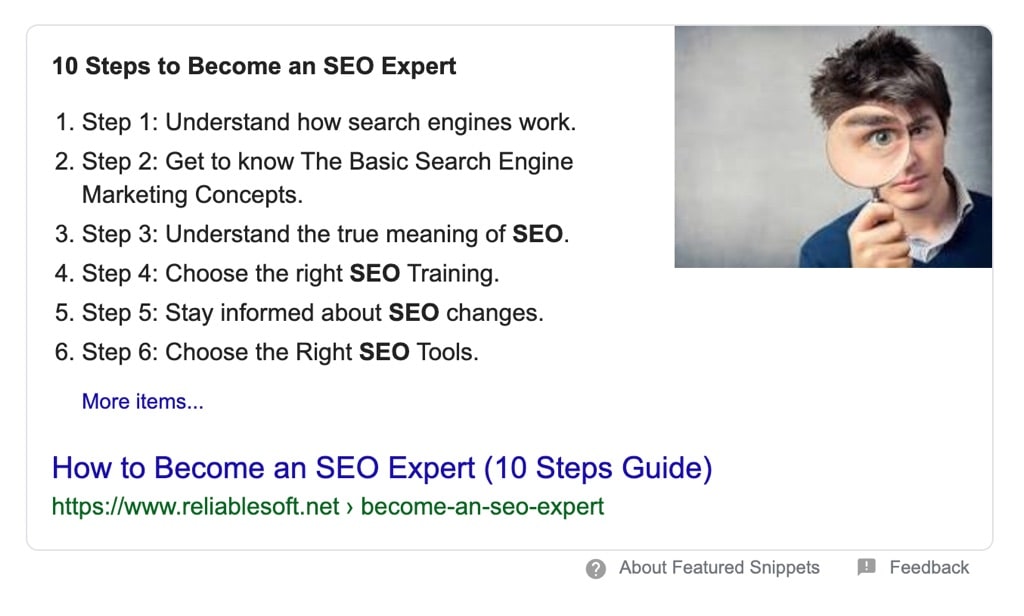
If you search for technical SEO, you’ll get a featured snippet that looks like this.
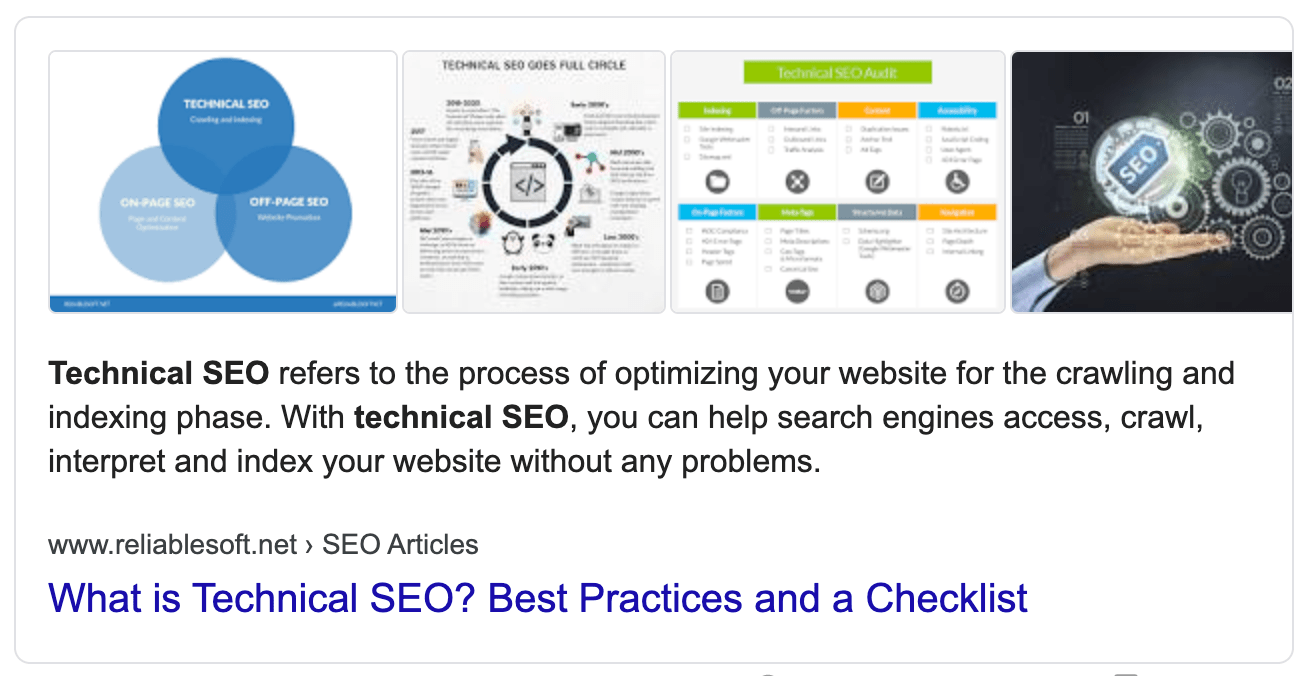
To make your pillar page eligible for a featured snippet, use the following tips:
- Add lists in your content using <ul> and <li> HTML tags
- Keep the list formatting simple (no custom bullets, arrows or another styling)
- Add a relevant title for each list
- Format the list title to be an H2 or H3
- Add the list(s) at the beginning of the page when possible
Optimize your pillar pages for sitelinks
Besides optimizing your pillar pages for featured snippets, you should also optimize them for page sitelinks.
Page sitelinks appear below in the search snippet below the meta description. They look like this:

Follow these tips:
- Each sub-section of your page should have a heading wrapped with an H2 or H3 tags
- For each heading add an “id” attribute
- Add a table of contents on top of the page (like in this article)
- Add internal links to the different section from your table of contents
Look again at the first diagram for a visual illustration.
7. Page formating
The last thing to do before hitting the publish button is to revisit your page formating.
This step is optional, it’s up to you to decide if you want your pillar pages to have a different format than the rest of your site pages. I prefer to use the same format across all my pages because it’s easier to manage but you can follow a different path.
One example of a pillar page that has a unique format is this from Typeform

Regardless of what design format you choose to follow, you need to make sure that:
- The page loads fast and looks good on all devices (especially mobile)
- It’s easy for people who like to do skim reading
- Your headings for the different sections are formatted differently from the rest of the content
- Any images or videos are properly optimized (alt text, schema, image compression)
- The page has a default featured image and it looks good when shared on social media networks.
8. Promote your page (internally and externally)
Once you get into this point, congratulations! You’re ready to hit the PUBLISH button and provide your users with a remarkable piece of content.
Publishing your pillar page is not the end of your work. You now need to promote your page both internally and externally. Let’s see what this means.
Promote your page Internally
As soon as you publish the page, search engines will get notified through your sitemap and in a matter of hours, they will index your new page.
To help them understand the importance of your page, and at the same make it easier for your users to find the page, you need:
- Add a link pointing to your pillar page from your homepage.
- Add a link pointing to your pillar page from your blog main page
- Add your pillar page to your sidebar (if you have sidebars)
- Add your pillar page to your main menu and footer
- Find related articles on your website and add internal links to your pillar page
Don’t omit this step, it’s important to give the right signals to search engine crawlers to let them know that this page is important for your site.
Promote your page Externally
You also need to promote your page on the Internet and try to get the attention of other bloggers with the ultimate goal of getting links and mentions.
This is part of what is known as off-page SEO and can positively influence your rankings in the short term but also long term.
Follow these tips:
- Send out a newsletter and inform your subscribers
- Publish your page on Facebook and use Facebook ads to promote the page to your existing audience (retargeting) and to new audiences
- Promote your page on Twitter (multiple times) and through twitter paid ads
- Promote your page on other social networks related to your niche (LinkedIn, Pinterest)
If your pillar page includes case studies, research or original data that can get the attention of the press, you can also write a press release and distribute it to all major networks.
If you added external links on your page, make sure that you contact the website owners and let them know about it. They will most probably share the page on their networks and some may even link back to it.
9. Write content for the supporting pages
While waiting for Google to rank your pillar page (it may take from two to six months), you can use the time to publish content that is related and supporting your pillar page.
For example, if your pillar page is about ‘content marketing’, you can write articles on topics that are not part of your pillar page like ‘SEO Copywriting’, ‘Content marketing tips’, ‘Content Promotion’ and link back to your pillar page.
This will help you a lot with SEO because not only you’ll get a chance to rank for the additional keywords but you can also strengthen your pillar page by pointing more internal links to it from highly related pages.
Great candidates for supporting articles are the long-tail keywords identified while doing keyword research (step 3) above.
10. Monitor the performance of your pillar pages
Last but not least, you need to monitor the performance of your pillar page. You have already dedicated a lot of time (and possibly money) creating the page, now its time to find out if it was worth the effort.
The most important KPIs to monitor are:
- Pageviews – How many times your pillar page was viewed
- Bounce rate – The percentage of people that landed on the page and exited without visiting a second page from your site. The lower the number the better.
- Email signups – How many people registered to your email list because of the pillar page
- Leads / Conversions – How many leads were generated from the pillar page
- Organic Traffic – How many people visited the page from search engines
- Rankings – for which keywords your page is ranking on Google and other search engines
- Visits from Social networks – Analyzed per network
- Social network interactions – how many people liked, shared or commented on your page
You can use Google analytics reports and Google search console to gather this data and add them to a spreadsheet or better yet to a Google Data Studio report.
Don’t rush into making conclusions, as mentioned above it may take a number of months for your page to reach its optimum rankings so you need to be patient.
Key Learnings
Ranking for high volume keywords is easier with pillar pages and topic clusters. The main purpose of creating a pillar page is to serve the user better and if this done correctly, search engines will follow.
There are two ways to approach this process. The first is by making a comprehensive page that includes all the information about a topic and the second is to have the main page (to be used as an introduction) and separate pages for the sub-topics.
Of course, you can always combine the two methods and have a pillar page with in-depth information and separate sub-pages for the additional topics.
The process to create a pillar page is similar to the process of creating an article.
First, you find the topic to target, decide on the format to use and then you do your keyword research. Based on the results of your research you design the structure of your pillar page or topic cluster and write the content.
Before publishing, you SEO optimize your text and after publication, you promote it as good as possible.
Should you create pillar pages for all the keywords you want to target? If you can afford it (in terms of money and time) then go for it but if time and money are an issue (in most cases this is the case) then use pillar pages for topics that really matter for your business.
What I always do before making a decision is to run a few searches on Google and examine the results. If for a topic I don’t need to create a pillar page then I write a normal article, it’s faster and cost-effective.





Thanks Alex, the guide is very helpful and valuable. As I am going to start blogging so I found it really helpful to fix my silos.